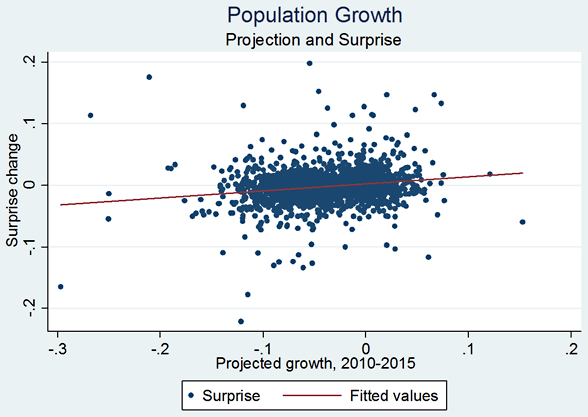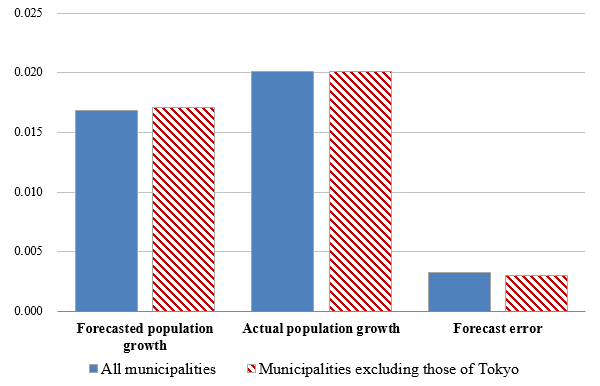Forecast error and future uncertainty
The population of many municipalities in Japan is forecasted to decrease in the coming years. However, forecasts are always inaccurate, and it is quite normal for actual figures to turn out to be somewhat higher or lower than predicted. Government policy makers need to keep in mind that forecasted figures have inherent uncertainty.
For example, consider the government's annual economic outlook, which is a major economic forecast in Japan. More often than not, the Japanese economy underperformed predictions in recent years, growing at an average real rate of 0.9% per year since 2000 compared to 1.4%, which is the average of initially predicted growth rates. The mean forecast error in absolute terms is 1.5 percentage points, meaning that there is a considerable degree of uncertainty about the future course of the economy.
In the case of economic performance indicators, a significant difference between predicted and actual values is taken as a surprise and impacts the financial market, sparking volatility in stock prices, long-term interest rates, foreign exchange rates, and so forth. Even if industrial production and employment indicators show significant changes from that of the previous month, the impact on the market would be limited if they are in line with market expectations. Conversely, actual numbers that deviate greatly from predictions would elicit strong market reactions. In macroeconomics, ex post forecast error is often used as a proxy variable for ex ante uncertainty (Morikawa 2016). This idea is quite natural because actual results are more likely to deviate from predictions when there is greater uncertainty about the future. As such, differences between predictions and actual results often contain important information.
Long-term predictions such as population forecasts are also affected significantly by subsequent events that were unpredictable at the time they were made, such as structural changes and natural disasters. Therefore, population prospects for some regions may be more serious than predicted.
How uncertain are population forecasts for municipalities?
The National Institute of Population and Social Security Research (NIPSSR)'s projections of Japanese population by region are used extensively, for instance, by the central government in formulating policies for regional revitalization as well as by municipalities in drawing up population visions for their respective regions (Note 1). They were also used as the basis for calculations in Chiho Shometsu [Extinction of Rural Municipalities], a book that has attracted a great deal of attention by presenting an alarming prospect for rural Japan, noting that 896 cities, wards, towns, and villages across Japan are facing the risk of extinction (Masuda 2014). "Regional Population Projections for Japan: 2010-2040 (Estimates as of March 2013)," which provides population projections through 2040 by municipality at the levels of prefectures and the smallest administrative units (i.e., cities, wards, towns, and villages) based on the 2010 Population Census, is the primary source for figures used today.
The population census is conducted every five years and the preliminary results of the 2015 Population Census were released in February 2016. In this article, I will compare those actual figures from the latest census with the earlier projections to determine the degree of deviations, and explore what characteristics such deviations exhibit in terms of direction and size. Approximately 1,800 cities, wards, towns, and villages, for which the two data sets have been linked, were taken as a sample (Note 2).
Table 1 shows some examples of municipalities that exhibit significant upward or downward deviations. The actual population exceeded the forecast by more than 10% in some municipalities such as Chuo ward in the city of Osaka, Shingumachi in Fukuoka prefecture, and Taiwacho in Miyagi prefecture. Meanwhile, three municipalities in Tokyo—Higashimurayama, Kunitachi, and Toshima ward—show significant downward deviations, with the actual population falling below the projected level by about 5%. To be sure, these figures represent the difference between actual and predicted population sizes, not an increase or decrease over the years between 2010 and 2015.
| Municipality (Cities, wards, towns, and villages) |
2015 population (Estimates) |
2015 population (Actual) |
Forecast error |
|---|---|---|---|
| Chuo ward, Osaka | 80,314 | 93,037 | 15.8% |
| Chiyoda ward, Tokyo | 50,380 | 58,344 | 15.8% |
| Shingumachi, Fukuoka pref. | 26,565 | 30,339 | 14.2% |
| Taiwacho, Miyagi pref. | 24,861 | 28,252 | 13.6% |
| Tochigi, Tochigi pref. | 140,483 | 159,267 | 13.4% |
| Minato ward, Tokyo | 215,317 | 243,390 | 13.0% |
| Taito ward, Tokyo | 177,037 | 198,512 | 12.1% |
| Naniwa ward, Osaka | 62,201 | 69,673 | 12.0% |
| Tsukubamirai, Ibaraki pref. | 43,884 | 49,146 | 12.0% |
| Shibuya ward, Tokyo | 205,192 | 224,815 | 9.6% |
| Susono, Shizuoka pref. | 54,965 | 52,737 | -4.1% |
| Yoshidacho, Shizuoka pref. | 30,348 | 29,113 | -4.1% |
| Inagawacho, Hyogo pref. | 32,181 | 30,851 | -4.1% |
| Nasumachi, Tochigi pref. | 26,068 | 24,922 | -4.4% |
| Gose, Nara pref. | 28,173 | 26,888 | -4.6% |
| Toshima ward, Tokyo | 305,319 | 291,066 | -4.7% |
| Kunitachi, Tokyo | 77,011 | 73,274 | -4.9% |
| Yamagata, Gifu pref. | 28,515 | 27,118 | -4.9% |
| Kandamachi, Fukuoka pref. | 36,787 | 34,984 | -4.9% |
| Higashimurayama, Tokyo | 158,037 | 150,130 | -5.0% |
| Note: Among the municipalities with a population of 20,000 or more in 2015, the top 10 municipalities with the largest upward deviations and those with the largest downward deviations are selected. | |||
The standard deviation of forecast error (surprise) for the sampled municipalities is 2.8% (Note 3). Although this is not an outrageously large number, it means that the actual population in 2015 exceeded or fell below the forecast by 3% or more in approximately 30% of the sampled municipalities (Note 4). It is well known that, as a general rule, long-term economic forecasts are subject to greater forecast error than short-term economic forecasts. We need to understand that forecasts for two or three decades ahead contain even greater error. Demographic trends in the future have a profound impact on the quantity and quality of public services for local residents, the development and improvement of infrastructure, the finance of local governments, and so forth. It is thus desirable to make policy plans based on the assumption that population forecasts involve such uncertainty.
However, what does this mean to local governments in concrete terms? Figure 1 plots the relationship between projected population growth over the period 2010-2015 and ex post surprise. The approximate line representing the fitted values is sloped upward to the right, meaning that those municipalities for which a large increase in population had been forecasted tended to experience a significant upward deviation and those for which a large decrease had been forecasted tended to experience a significant downward deviation (Note 5). Although each municipality has its unique set of factors, it is nevertheless useful to keep in mind the existence of these tendencies. To be more specific, municipalities whose populations are forecasted to decrease significantly in the future should be fully aware of the possibility that they may suffer a greater population loss.

Upward deviations not confined to Tokyo but common to densely populated municipalities
A closer examination reveals the existence of a systematic relationship between the forecast error in the municipal population in 2015 and the population density of the municipality. For instance, the actual size of the population exceeded the forecast in most prefectural capital cities, which tend to be densely populated.
A quantitative analysis with a simple regression model, in which the population growth rate and forecast error are explained by the population density at the beginning of the period (2010), found that densely populated municipalities tend to exhibit upward deviations while sparsely populated municipalities often see downward deviations. Figure 2 shows the estimated elasticity of population growth in between 2010 and 2015 with respect to the population density of municipalities. While more densely populated municipalities tend to show a higher rate of population increase (lower rate of population decrease), the elasticity of actual population growth is greater than that of forecasted population growth. A twofold increase in the population density translates into a 1.2 percentage point increase in forecasted population growth and a 1.4 percentage point increase in actual population growth, resulting in an upward deviation of 0.2 percentage points.

Recently, the influx of population into the Tokyo metropolitan area—particularly the center of Tokyo—has been attracting much attention. However, the relationship between population density and population growth remains roughly the same in quantitative terms even if the municipalities of Tokyo are excluded from estimation (Figure 2). Meanwhile, when we estimate a regression equation by introducing "municipalities of Tokyo" as a dummy independent variable, the coefficient of the dummy variable is not statistically significant. Although rectifying unipolar centralization in Tokyo has been a keyword in the ongoing discussion on rural revitalization, the reality is that the greater than expected influx of population is not a phenomenon confined to Tokyo but also has been occurring in densely populated areas across Japan, such as prefectural capital cities. Productivity in service industries is higher in areas of agglomeration where population and employment density is higher (Morikawa 2016). Despite the existence of various institutional barriers inhibiting the mobility of people, a natural economic mechanism seems to be working as a driving force for rural-to-urban migration amid the changing industrial structure of Japan, namely, the increasing weight of service industries that are urban-oriented in nature. From the viewpoint of optimizing the entire Japanese economy, it is necessary to reduce and remove factors inhibiting the mobility of people. In addition, we need to have the perspective of applying "positive adjustment policies (PAPs)" in spatial terms to facilitate structural changes (Note 6).
Lastly, in order to avoid any misunderstanding, I would like to make it clear that this article has no intention to question the accuracy of the NIPSSR's population projections by region. Those projections, which are provided with a detailed explanation of underlying assumptions, are quite useful as a benchmark under certain assumptions. Indeed, I have been using those projections frequently. What is important is that each user, including the central and local governments, needs to keep in mind the uncertainty of forecasts in utilizing them.


